Preserving Summer’s Bounty: Considering the Savings
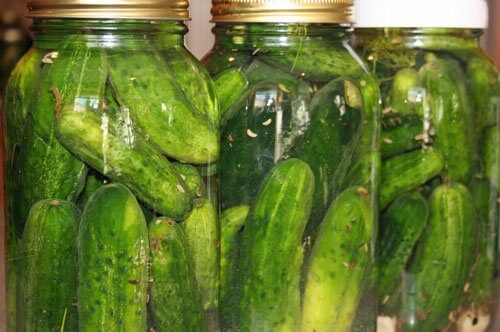
I’m definitely back in the saddle, doing a ton of preserving after a nice little mid-summer break.
I went to my local produce market on Thursday afternoon and decided it was high time that I stock up on some of the wonderful, seasonal deals that were available and get my little tush back into the kitchen to put it all away for the winter!
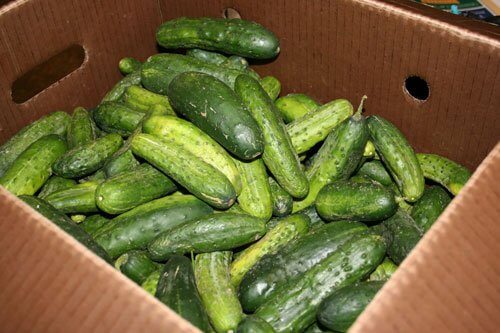
I started with this 20 lb box of pickling cucumbers. I bought a couple bundles of fresh dill to go along with it.
Using this lacto-fermented dill pickle recipe (but adding a few more spices this time– fennel, caraway, mustard powder, black peppercorns) as well as the Bread & Butter pickle recipe in that same post, I made a huge batch of pickles.

All of these, plus those 3 half-gallon jars in the very first picture. Yes, we really like pickles! Plus, they are fantastic for aiding our digestion and so we often eat a pickle or two when we sit down to lunch or dinner.
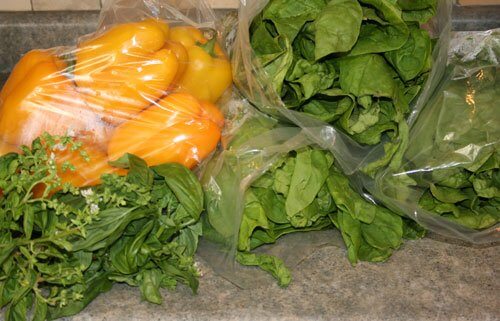
Next, I began to tackle this fresh spinach, yellow bell peppers, and basil (two bunches from my own garden, one from the market).
Spinach :: I did it exactly as I showed in this spinach freezing tutorial from last summer.
Peppers :: After washing, I diced them all into about 1×1 inch pieces, then put one pepper’s worth of pieces into little bags, and put all of those into a large Ziploc.
Basil :: I used the Nourishing Traditions pesto recipe as my base, but I sort of just made the pesto by feel and worked with what I had. Fresh basil, some spinach added (because I didn’t have quite enough basil), fresh garden garlic, parmesan cheese, sea salt, and cashews (because I didn’t have pine nuts), with extra virgin olive oil. Blended it all up in the food processor until it tasted good, then put it into two glass jars to freeze.
The spinach I like to use in scrambled eggs, omelettes or quiche, Spinach Rice Casserole, pastas, soups, etc. The peppers will be perfect for pizzas or casseroles throughout the winter, when peppers shoot up to several dollars per lb. The pesto is for pasta, sandwiches, pizza or just whatever sounds good!
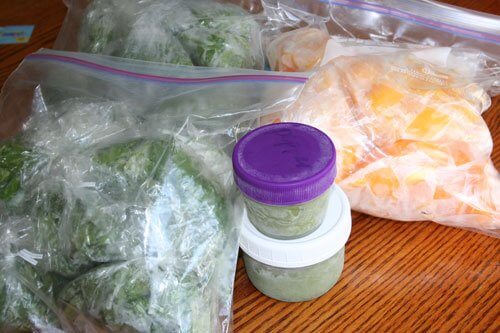
While I was working away yesterday, I started trying to figure out how much I was saving, by buying seasonally and preserving the food myself. Here’s what I came up with:
Costs
$26.50 Pickling cucumbers- 20 lbs
$4.00 Fresh (unsprayed) dill- two bunches
$2.67 Fresh (unsprayed) spinach- 3 humongous bunches
$2.76 Yellow peppers, local- 4 lbs
$3.98 Basil (unsprayed)- 2 bunches
$0.00 Garlic and 1 bunch basil (from my garden)
$4.00 Herbs, spices, salt, olive oil, parmesan cheese, whey (this is an estimate, but there’s no way it cost more than this)
Total = $43.91
Savings
$95.00 – Pickles at $5.00 per 1 quart jar (for Bubbie’s, the brand we buy, very comparable in type/quality of pickles)
$7.96 – Yellow peppers (this is a very LOW estimate, at $1.99/lb compared to the $0.69/lb I paid this week. Often in winter, they get as high as $2.49 or even $2.99 at the market I shop at, or even $3.99 in grocery stores)
$29.85 – For 15 packages of frozen spinach at $1.99 per package. If I was buying it all fresh in the winter, the price could potentially be even higher than that.
$6.99 – I believe this is the cost of a comparable size jar of pesto at Costco. Except that half of my ingredients are organic, unlike the Costco one.
Total = $139.80
That is a savings of $95.89, or about 65%!
And that is why preserving is worth it to me. Wholesome, nourishing foods for my family at a fraction of the price. Not to mention the ability to support local farmers growing great food in season.
I should also mention that the time it takes to do all of this isn’t that unrealistic either. I put up 19 quarts (4 3/4 gallons) of pickles in about 2 hours Friday morning, then took a break to get dolled up and take my hubby out for a special birthday lunch. Later in the afternoon while the little ones slept, I put in another 2-3 hours making pesto, and dealing with the peppers and spinach, while making dinner and tidying the house for a birthday gathering.
**Did you see the huge list of food preserving tutorials, recipes and resources that I’ve put together? Check it out and then bookmark it for later reference!**




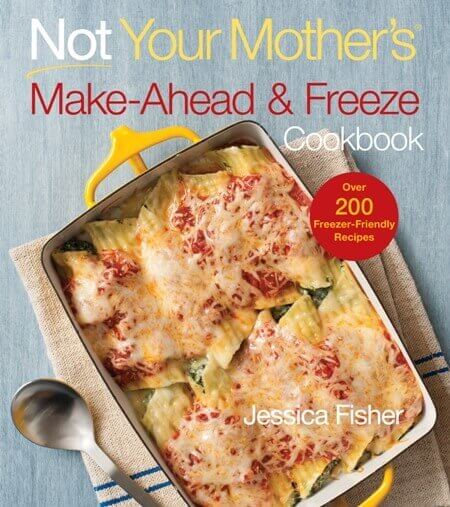

A tip for the peppers – sometimes the potent smell of peppers can seep out and give all the contents of the freezer a pepper twinge. (bread or vanilla ice cream that smells like peppers is just not the same:-)) I find that double bagging – inside a second large zip top bag makes a big difference in keeping the aroma contained.
In this season of my life I have only a small, under-counter freezer and fridge, so freezing to put things aside isn’t in the cards. But when I had an ‘American size’ freezer my own garden peppers were the thing that I got the most pleasure and reward from freezing. The year our power went out for 9 days and I lost that year’s peppers I was terribly sad:-(
On your post with the pickle recipes, you say to slice the cucumbers for the garlic dill recipe. In your picture here they are whole, right? So does it matter?
@amy, It doesn’t matter too much. Last year I sliced them. This year I decided to keep them whole, partly because I have decided that I think it keeps them a bit crisper, and partly because it was a LOT less work than slicing that many cucumbers. 🙂
One more question…..I have not ever bought whey, so I don’t know what i’m looking for. Is something like this what I should use?
http://www.amazon.com/Bobs-Red-Mill-Concentrate-12-Ounce/dp/B000EDG5CA/ref=sr_1_7?ie=UTF8&s=hpc&qid=1283798154&sr=8-7
@Amy T., No, that’s actually a completely different product.
The whey I’m talking about is the yellowish liquid that you get when you let raw milk curdle and separate. I let mine sit on the counter for a day or two, then I strain out the curds (to make soft cheese, like cream cheese) and the liquid that’s left is the whey. That’s what I use as a starter for my pickles, etc.
Oh I see….I don’t have access to raw milk. Would regular organic milk work? Or is there an alternative to whey? Or what would happen if it was left out?
@amy, Unfortunately regular organic milk wouldn’t give you whey. Instead, because it is pasteurized, it would simply go bad on your counter and become putrid. 🙁
Instead, you could take yogurt and strain it through cheesecloth or something similar. The liquid that would come off of it is also whey. That’s an easy way to get it when you don’t have raw milk.
The other option is that you can up the salt content, in place of whey. Personally, I don’t like doing that because I find it becomes a bit too salty, but it does work.
I didn’t know you could just chop and freeze bell peppers – do the come out well in the winter? How do they last? I would love to do this while they are so cheap! They run 4.99 – 5.99 per pound in Montana in the winter so I would love to stock up now!
@Kelli, They’re fine for some things, but not for others. They do lose some of their crispness, so they won’t be like they are when they are fresh and raw. After freezing, they’re more suited to being used in cooked dishes instead, but if you use them that way in the winter then definitely stock up now!
Oh, I’m trying not to be jealous! It’s times like these that I wish I lived in a different state. Living in Alaska is grand, but when produce is expensive and elusive all year, it’s sad to think about. 🙁 I know we are blessed by the availability at all (I thank God for bananas and tomatoes at Fred Meyers in January) That said, I know people who do manage to grow a big garden (sometimes because of greenhouses) and can and freeze produce all kinds of goodies up here, it’s just a lot more challenging. We tried ordering a box of pickling cucumbers from Azure last year to can, and when they arrived they were fuzzy. 🙁 We did, however, take advantage of a big sale on apples and make some yummy frozen applesauce. Still, I am learning and re-thinking ways to actually “harvest” what bounty we have here in Alaska.
Do you have any idea if Lacto-fermented cucumbers would be a problem for someone who has milk allergies?
@Andrea,
Andrea, I have noticed sometimes with Azure’s organic produce that it doesn’t stay fresh long. My Mom order organic lemons and they molded very quickly.
Andrea, I use the whey for some fermenting, but if I know my grandson is going to even think about eating it, who is autistic and cannot do dairy in any form, I just add the extra bit of salt she calls for in her recipe instead of the whey. The pickles are just as awesome and just as nutritious for my grandson who needs all the probiotics he can get. It does make it a bit saltier, but that is a small price to pay to see his face light up when he can eat what everyone else is having.
@Andrea, Lacto-fermented wouldn’t be a problem for someone with milk allergies- the name has nothing to do with the dairy. Of course, it depends on whether you’re using whey to make them or not and the seriousness of the allergy. You can make them without whey, substituting salt instead. I buy Bubbie’s brand from Azure, which are L-F, and they don’t use any whey.
Stephanie,
I learned last year that leaving the cheese out of the pesto during freezing gives you a better product. Mine was too rubbery when I thawed it out if I used the cheese. So now I add the cheese when serving.
Kris
@Kris Mays, Oh, interesting. I’ll have to see how this turns out with the cheese, then, and maybe do it that way next year instead.
I know I’m saving a ton. I’m getting a bunch of tomatoes FREE from friends and through my CSA (extra tomatoes; I’m “supposed” to get about 3 lbs. but my farmer has been giving me more like 20 lbs. each week because he knows I’m canning!), plus I am buying them 25 lbs. for $17.50! I’m estimating it’s costing me less than $3/qt for sauce, compared to $5 or more I’d pay in the store. I’m eager to get into apples soon, but the ones I really want don’t ripen until the end of Oct. I will probably do a mix of varieties. I also got green peppers 6 for $1! I could pay 3 or 4 times that in the winter! I seeded and halved them and froze them that way, because we really love stuffed peppers. I got peaches for around $1/lb and canned about 20 lbs. and froze another 30 lbs. (kids like to eat them frozen and we like them in smoothies). I got a TON of basil through my CSA and have dried quite a bit, and blended some with olive oil and froze it.
Although this isn’t “summer’s bounty” per se, we’re also about to get 1/2 a pig! We’ll get the lard and the bones with it and spend about $200 for all that plus 75 lbs. of meat. That’s going to REALLY cut down on our grocery costs here soon. So has buying chicken feet and other “yucky” parts for only $1.50/lb.
This the first year I’ve done preserving but I am loving it.
I have never made pickles before or done lacto fermenting. I really want to try this. My question is: Do you have to store them in the fridge? I would not be able to make this if I did. I’m wondering how this is different than pickles at the store that are on the shelf?
Thanks Kim